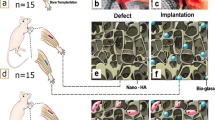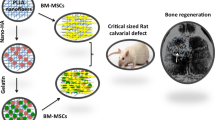Abstract
45S5-type bioactive glasses are a promising alternative to established substitutes for the treatment of bone defects. Because the three-dimensional (3D) structure of bone substitutes is crucial for bone ingrowth and formation, we evaluated the osteoinductive properties of different polymer coated 3D-45S5 bioactive glass (BG) scaffolds seeded with human mesenchymal stem cells (hMSC) in vivo. BG scaffolds coated with gelatin, cross-linked gelatin, and poly(3-hydroxybutyrate-co-3-hydroxyvalerate) were seeded with hMSC prior to implantation into severe combined immunodeficiency mice. Newly formed bone was evaluated with histomorphometry and micro-computed tomography. Bone formation was detectable in all groups, whereas the gelatin-coated BG scaffolds showed the best results and should be considered in further studies.
Graphical Abstract




Similar content being viewed by others
References
Moghaddam A, Zietzschmann S, Bruckner T, Schmidmaier G. Treatment of atrophic tibia non-unions according to ‘diamond concept’: results of one- and two-step treatment. Injury. 2015;46(Suppl 4):S39–50. doi:10.1016/S0020-1383(15)30017-6.
Miska M, Findeisen S, Tanner M, Biglari B, Studier-Fischer S, Grutzner PA, et al. Treatment of nonunions in fractures of the humeral shaft according to the diamond concept. Bone Joint J B. 2016;98(1):81–7. doi:10.1302/0301-620X.98B1.35682.
Westhauser F, Zimmermann G, Moghaddam S, Bruckner T, Schmidmaier G, Biglari B, et al. Reaming in treatment of non-unions in long bones: cytokine expression course as a tool for evaluation of non-union therapy. Arch Orthop Trauma Surg. 2015;135:1107–16.
Janicki P, Schmidmaier G. What should be the characteristics of the ideal bone graft substitute? Combining scaffolds with growth factors and/or stem cells. Injury. 2011;42(Suppl 2):S77–81. doi:10.1016/j.injury.2011.06.014.
Ilharreborde B, Morel E, Fitoussi F, Presedo A, Souchet P, Pennecot GF, et al. Bioactive glass as a bone substitute for spinal fusion in adolescent idiopathic scoliosis: a comparative study with iliac crest autograft. J Pediatr Orthop. 2008;28(3):347–51. doi:10.1097/BPO.0b013e318168d1d4.
Pernaa K, Koski I, Mattila K, Gullichsen E, Heikkila J, Aho AJ, et al. Bioactive glass S53P4 and autograft bone in treatment of depressed tibial plateau fractures—a prospective randomized 11-year follow-up. J Long Term Eff Med Implant. 2011;21(2):139–48. doi:10.1615/JLongTermEffMedImplants.v21.i2.40.
Hu S, Chang J, Liu M, Ning C. Study on antibacterial effect of 45S5 Bioglass. J Mater Sci Mater Med. 2009;20(1):281–6. doi:10.1007/s10856-008-3564-5.
Hoppe A, Guldal NS, Boccaccini AR. A review of the biological response to ionic dissolution products from bioactive glasses and glass-ceramics. Biomaterials. 2011;32(11):2757–74. doi:10.1016/j.biomaterials.2011.01.004.
Dapunt U, Spranger O, Gantz S, Burckhardt I, Zimmermann S, Schmidmaier G, et al. Are atrophic long-bone nonunions associated with low-grade infections? Ther Clin Risk Manag. 2015;11:1843–52. doi:10.2147/TCRM.S91532.
Chen QZ, Thompson ID, Boccaccini AR. 45S5 Bioglass-derived glass-ceramic scaffolds for bone tissue engineering. Biomaterials. 2006;27(11):2414–25. doi:10.1016/j.biomaterials.2005.11.025.
El-Gendy R, Yang XB, Newby PJ, Boccaccini AR, Kirkham J. Osteogenic differentiation of human dental pulp stromal cells on 45S5 Bioglass(R) based scaffolds in vitro and in vivo. Tissue Eng Part A. 2013;19(5–6):707–15. doi:10.1089/ten.TEA.2012.0112.
Arkudas A, Balzer A, Buehrer G, Arnold I, Hoppe A, Detsch R, et al. Evaluation of angiogenesis of bioactive glass in the arteriovenous loop model. Tissue Eng Part C. 2013;19(6):479–86. doi:10.1089/ten.TEC.2012.0572.
Karageorgiou V, Kaplan D. Porosity of 3D biomaterial scaffolds and osteogenesis. Biomaterials. 2005;26(27):5474–91. doi:10.1016/j.biomaterials.2005.02.002.
Arabnejad S, Burnett Johnston R, Pura JA, Singh B, Tanzer M, Pasini D. High-strength porous biomaterials for bone replacement: a strategy to assess the interplay between cell morphology, mechanical properties, bone ingrowth and manufacturing constraints. Acta Biomater. 2016;30:345–56. doi:10.1016/j.actbio.2015.10.048.
Kaur G, Pandey OP, Singh K, Homa D, Scott B, Pickrell G. A review of bioactive glasses: their structure, properties, fabrication and apatite formation. J Biomed Mater Res A. 2014;102(1):254–74. doi:10.1002/jbm.a.34690.
Westhauser F, Weis C, Hoellig M, Swing T, Schmidmaier G, Weber M-A, et al. Heidelberg-mCT-analyzer: a novel method for standardized microcomputed-tomography-guided evaluation of scaffold properties in bone and tissue research. R Soc Open Sci. 2015;2:150496. doi:10.1098/rsos.150496.
Kuehlfluck P, Moghaddam A, Helbig L, Child C, Wildemann B, Schmidmaier G. RIA fractions contain mesenchymal stroma cells with high osteogenic potency. Injury. 2015;46(S8):S2–11.
Philippart A, Boccaccini AR, Fleck C, Schubert DW, Roether JA. Toughening and functionalization of bioactive ceramic and glass bone scaffolds by biopolymer coatings and infiltration: a review of the last 5 years. Expert Rev Med Devices. 2015;12(1):93–111. doi:10.1586/17434440.2015.958075.
World Medical A. World Medical Association Declaration of Helsinki: ethical principles for medical research involving human subjects. JAMA. 2013;310(20):2191–4. doi:10.1001/jama.2013.281053.
Dominici M, Le Blanc K, Mueller I, Slaper-Cortenbach I, Marini F, Krause D, et al. Minimal criteria for defining multipotent mesenchymal stromal cells. the international society for cellular therapy position statement. Cytotherapy. 2006;8(4):315–7. doi:10.1080/14653240600855905.
Li W, Nooeaid P, Roether JA, Schubert DW, Boccaccini AR. Preparation and characterization of vancomycin releasing PHBV coated 45S5 Bioglass®-based glass–ceramic scaffolds for bone tissue engineering. J Eur Ceram Soc. 2014;34:505–14. doi:10.1016/j.jeurceramsoc.2013.08.032.
Li W, Wang H, Ding Y, Scheithauer EC, Goudouri O-M, Grunewald A, et al. Antibacterial 45S5 Bioglass®-based scaffolds reinforced with genipin cross-linked gelatin for bone tissue engineering. J Mater Chem B. 2015;3:3367–78.
Brocher J, Janicki P, Voltz P, Seebach E, Neumann E, Mueller-Ladner U, et al. Inferior ectopic bone formation of mesenchymal stromal cells from adipose tissue compared to bone marrow: rescue by chondrogenic pre-induction. Stem Cell Res. 2013;11(3):1393–406. doi:10.1016/j.scr.2013.07.008.
Bouxsein ML, Boyd SK, Christiansen BA, Guldberg RE, Jepsen KJ, Muller R. Guidelines for assessment of bone microstructure in rodents using micro-computed tomography. J Bone Miner Res. 2010;25(7):1468–86. doi:10.1002/jbmr.141.
Chang B, Song W, Han T, Yan J, Li F, Zhao L, et al. Influence of pore size of porous titanium fabricated by vacuum diffusion bonding of titanium meshes on cell penetration and bone ingrowth. Acta Biomater. 2016;. doi:10.1016/j.actbio.2016.01.022.
Acknowledgments
The authors thank Tyler Swing for proofreading, Tom Bruckner for the support according the statistical analysis, and Birgit Frey for histomorphometric processing. This study was financed by the research grant of the Center of Orthopedics, Traumatology, and Spinal Cord Injury, Heidelberg University Hospital.
Author information
Authors and Affiliations
Corresponding author
Additional information
Fabian Westhauser and Christian Weis have contributed equally to this work.
Rights and permissions
About this article
Cite this article
Westhauser, F., Weis, C., Prokscha, M. et al. Three-dimensional polymer coated 45S5-type bioactive glass scaffolds seeded with human mesenchymal stem cells show bone formation in vivo. J Mater Sci: Mater Med 27, 119 (2016). https://doi.org/10.1007/s10856-016-5732-3
Received:
Accepted:
Published:
DOI: https://doi.org/10.1007/s10856-016-5732-3




